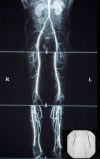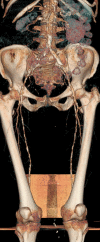Optimal management of peripheral arterial disease for the non-specialist
- PMID: 22347739
- PMCID: PMC3281253
Optimal management of peripheral arterial disease for the non-specialist
Abstract
Peripheral arterial disease (PAD) now affects approximately 20% of adults older than 55 years to an estimated total of 27 million people in the Western World. The aim of this paper is to describe the medical management of PAD for the non-vascular specialist, particularly general practitioners, where PAD has now been included in the Northern Ireland Department of Health's Primary Care Service Framework (Directed Enhanced Service).
Keywords: Epidemiology; Investigation; Peripheral Arterial Disease; Treatment.
Figures







Similar articles
-
Peripheral arterial disease: current perspectives and new trends in management.South Med J. 2009 Nov;102(11):1141-9. doi: 10.1097/SMJ.0b013e3181bb9ab8. South Med J. 2009. PMID: 19864983 Review.
-
[Obliterating arterial disease of the legs in women].Presse Med. 2010 Feb;39(2):263-70. doi: 10.1016/j.lpm.2009.04.015. Epub 2009 Dec 16. Presse Med. 2010. PMID: 20015610 French.
-
Factors affecting the validity of ankle-brachial index in the diagnosis of peripheral arterial obstructive disease.Angiology. 2010 May;61(4):392-6. doi: 10.1177/0003319709348295. Epub 2009 Sep 16. Angiology. 2010. PMID: 19759029
-
Peripheral arterial disease: considerations in risks, diagnosis, and treatment.J Natl Med Assoc. 2009 Oct;101(10):999-1008. doi: 10.1016/s0027-9684(15)31066-x. J Natl Med Assoc. 2009. PMID: 19860299 Review.
-
Inter-society consensus for the management of peripheral arterial disease.Int Angiol. 2007 Jun;26(2):81-157. Int Angiol. 2007. PMID: 17489079 Review. No abstract available.
Cited by
-
Vein graft failure: from pathophysiology to clinical outcomes.Nat Rev Cardiol. 2016 Aug;13(8):451-70. doi: 10.1038/nrcardio.2016.76. Epub 2016 May 19. Nat Rev Cardiol. 2016. PMID: 27194091 Review.
-
Assessment of effectiveness of endovascular treatment of common and external iliac artery stenosis/occlusion using self-expanding Jaguar SM stents.Pol J Radiol. 2012 Oct;77(4):22-9. doi: 10.12659/pjr.883625. Pol J Radiol. 2012. PMID: 23269933 Free PMC article.
-
Perineural local anaesthetic catheter after major lower limb amputation trial (PLACEMENT): study protocol for a randomised controlled pilot study.Trials. 2017 Dec 28;18(1):629. doi: 10.1186/s13063-017-2357-x. Trials. 2017. PMID: 29284534 Free PMC article.
-
Living a burdensome and demanding life: A qualitative systematic review of the patients experiences of peripheral arterial disease.PLoS One. 2018 Nov 15;13(11):e0207456. doi: 10.1371/journal.pone.0207456. eCollection 2018. PLoS One. 2018. PMID: 30440040 Free PMC article.
-
Barriers and enablers to walking in individuals with intermittent claudication: A systematic review to conceptualize a relevant and patient-centered program.PLoS One. 2018 Jul 26;13(7):e0201095. doi: 10.1371/journal.pone.0201095. eCollection 2018. PLoS One. 2018. PMID: 30048501 Free PMC article.
References
-
- Sigvant B, Wiberg-Hedman K, Bergqvist D, Rolandsson O, Andersson B, Persson E, et al. A population-based study of peripheral arterial disease prevalence with special focus on critical limb ischemia and sex differences. J Vasc Surg. 2007;45(6):1185–91. - PubMed
-
- Norgren L, Hiatt WR, Dormandy JA, Nehler MR, Harris KA, Fowkes FG, et al. Inter-Society Consensus for the Management of Peripheral Arterial Disease (TASC II) Eur J Vasc Endovasc Surg. 2007;33(Suppl 1):S1–75. - PubMed
-
- Schmieder FA, Comerota AJ. Intermittent claudication: magnitude of the problem, patient evaluation, and therapeutic strategies. Amer J Cardiol. 2001;87(12A):3D–13D. - PubMed
-
- McDermott MM. The magnitude of the problem of peripheral arterial disease: epidemiology and clinical significance. Cleve Clin J Med. 2006;73(Suppl 4):S2–7. - PubMed
-
- Second European Consensus Document on chronic critical leg ischaemia, editor. Eur J Vasc Surg. 1992;6(Supp A):1–32. - PubMed
Publication types
MeSH terms
LinkOut - more resources
Full Text Sources
